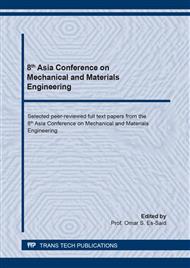p.15
p.25
p.30
p.36
p.45
p.51
p.57
p.64
p.70
Ultimate Strength Prediction of Fibrous Composites only upon Independently Measured Constituent Properties
Abstract:
This study presents an accurate and easy-to-use micromechanical model to predict the ultimate strength of unidirectional polymer composites under an arbitrary load condition only upon independently measured constituent properties. In this model, the micromechanical method based on generalized model of cells (GMC), which effectively predict the nonlinear deformation of unidirectional composites, is used to analyze the repeating unit cells of composites. At the same time, a unified plastic theory (i.e. modified Ramaswamy-Stouffer model) is incorporated into the GMC's analytical framework to describe viscoplastic behaviors of matrix phase. Additionally, because of the stress concentration effect which causes the difference between the matrix in-situ and original strength behaviors, a stress concentration factor is introduced in order to utilize the measured constituent properties directly. The prediction results with SCF match better with the experimental results than the prediction results without SCF. In addition, the prediction results show that the presence of thermal residual stress and material plastic effects generally has important influence on the strength prediction of a composite.
Info:
Periodical:
Pages:
45-50
Citation:
Online since:
November 2020
Authors:
Price:
Сopyright:
© 2020 Trans Tech Publications Ltd. All Rights Reserved
Share:
Citation:


